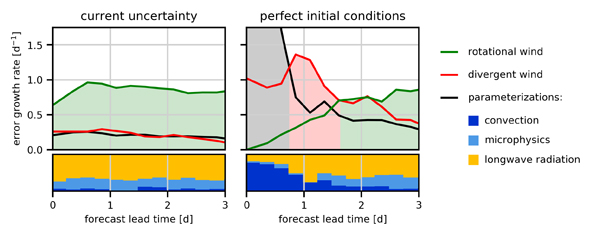Which physical processes limit predictability?
17.11.2021

Based on simulations with the ICON model of the German Weather Service (DWD), we investigated how errors and uncertainties in the initial condition of the weather forecast limit predictability, and what improvements will still be possible in the future. To do this, the initial condition uncertainty was artificially reduced by a factor of 1000, to represent (almost) perfect initial conditions. The model experiments showed that even with this enormous improvement only a relatively small extension of the predictable period by about five days could be achieved.
With the help of a novel analysis tool, which has been developed at the University of Mainz, the reason for this behavior was revealed: The physical processes that initially dominate the error growth change when the initial uncertainty is reduced. The situation today is shown on the left-hand side of the figure. Here, error growth is driven by the rotational wind component, which is characteristic for the circulation in large-scale weather systems like highs and lows. The right-hand side of the figure shows the situation for the hypothetical 1000-fold reduction of the initial error, a quasi perfect initial state. Now processes like precipitation and convection dominate the error growth initially. These occur on much smaller scales compared to the highs and lows, and obtain their energy from the condensation of water vapor. Through scale interactions they also limit the longer-range, large-scale forecast skill and make further improvements impossible.
Selz, T., M. Riemer, and G. Craig, 2021: The transition from practical to intrinsic predictability of midlatitude weather. Submitted to JAS.

